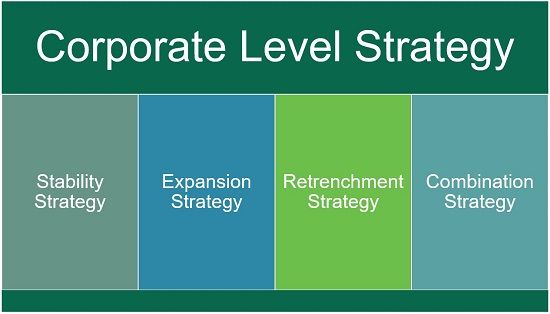Definition: Corporate-Level Strategy refers to the top management’s approach or game plan for administering and directing the entire concern. These are based on the company’s business environment and internal capabilities. It also called as Grand Strategy.
It reflects the combination and pattern of business moves, actions and hidden goals, in the strategic interest of the concern, considering various business divisions, product lines, customer groups, technologies and so forth.
Salient Features of Corporate Level Strategy
- Corporate Level Strategies is developed by the company’s highest level of management considering the company’s overall growth and opportunities in future.
- It describes the orientation and direction of the enterprise in the long run and the overall boundaries which acts as the basis for formulating the company’s middle and low-level strategies, i.e. business strategies and functional strategies.
- While formulating corporate-level strategies, the company’s available resources and environmental factors are kept in mind.
- It is concerned with the decisions regarding the two-way flow of company’s information and resources between the various levels of management.
In better words, corporate-level strategy implies the topmost degree of strategic decision making, which covers those business plans which are concerned with the company’s objective, procurement and optimal allocation of resources and coordination of business strategies of different units and divisions for satisfactory performance.
Classification of Corporate-Level Strategies
The corporate-level strategies are classified into four parts:
Stability Strategy
Stability is a critical business goal which is required to defend the existing interest and strengths, to follow the business objectives, to continue with the existing business, to keep the efficiency in operations, etc.
In the stability strategy, the firm continues with its existing business and product markets, as well as it maintains the current level of endeavour as the firm is satisfied with the marginal growth.
Expansion Strategy
Also called a growth strategy, wherein the company’s business is reevaluated so as to extend the capacity and scope of business and considerably increasing the overall investment in the business.
In the expansion strategy, the enterprise looks for considerable growth, either from the existing business or product market or by entering a new business, which may or may not be related to the firm’s existing business. Basically, it encompasses diversification, merger and acquisitions, strategic alliance, etc.
Retrenchment Strategy
This is pursued when the company opts for decreasing its scope of activity or operations. In retrenchment strategy, a number of business activities are retrenched (cut or reduced) so as to minimize cost, as a response to the firm’s financial crisis. Sometimes, the business itself is dropped by selling out or liquidation.
Therefore, areas where there is a problem is identified and reasons for those problems are diagnosed, after that corrective or remedial steps are taken to solve those problems. So, when the firm concentrates on the ways to reverse the process of decline, it is called a turnaround strategy.
However, if it drops the loss-making venture or part of the company or minimizes the functions undertaken, it is called a divestment or divestiture strategy. If nothing works, then the firm may choose for closing down the firm, it is called a liquidation strategy.
Combination Strategy
In this strategy, the enterprise combines any or all of the three corporate strategies, so as to fulfil the firm’s requirements. The firm may choose to stabilize some areas of activity while expanding the other and retrenching the rest (loss-making ones).
The primary focus on corporate-level strategies is on the “directing” the managers on ‘how to manage the scope of various business activities’ and ‘how to make optimum utilization of firm’s resources (material, money, men, machinery), etc. on different business activities’.


Leave a Reply